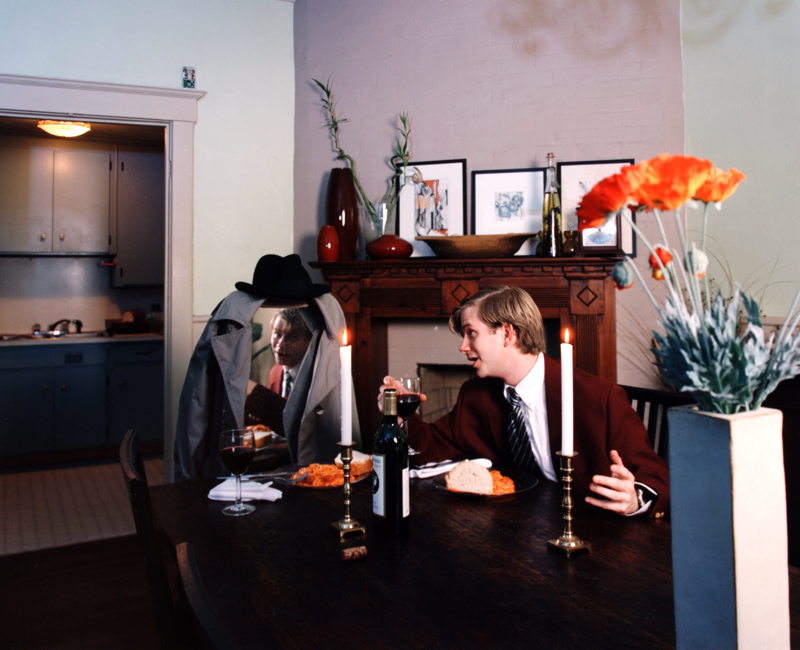And the Story Goes…
She had to sleep with every light on or sleep would never come. She housed twenty in her room alone, and possibly double that in her living room. Should we even get started on the kitchen? When the sun started disappearing over the horizon, there was never a moment when the lights were off. She began at 6:00 in the summers and 4:00 in the winters and would walk counter clockwise throughout the rooms breathing in emphatically as each glowing bulb came to life. She had tall skinny lamps for illuminating the corners of her ceilings and short, squat plastic ones to force the darkened nooks to scream daylight. They were plastic due to the occasions when, feeling she may be competing against the sunset, she kicked them over in her haste. Time could not be wasted on cleaning up shards of broken lamp glass.
Was it the Boogeyman that compelled her to fear the fall of darkness? Possible alien abduction? Ghosts, ghouls, and drooling monsters? Couldn’t she just get a dog? She shrugged off those questions with a sigh. “I love daylight! If it’s always sunny my day never ends. It’s like I’m living one long, beautifully lit day.”
There is an element of truth embedded in this story about how I fall asleep at night. No, there is no seasonal ritual, but at times I discover that certain rooms must “check out” and questionable corners need to be lit. I would love to explain my obsession as a mere preference as the character in the above story does, but my situation is real—and the aforementioned is pure fiction. Most narrative works teeter between a factual occurrence and a fictionalized version by the author. I prefer to exaggerate the story further; draw the audience in with a detailed examination of a character’s odd, habitual actions. If a person relates to my main character’s quirks, then maybe I can be more comfortable with mine. Storytelling is the ultimate tool to relate an experience and draw a person into another realm of reality. How else could a person identify with a seemingly opposite being? If one hears or views a narrative unfolding, he must supply a logical placement for these characters and settings to briefly exist for the duration of the tale. If the story has a hint of realism, an audience member will believe it through the mere possibility of it having happened to someone somewhere. A story allows the mind to think; it is not just regurgitating facts from a report, instead it is interpreting and questioning the information it is receiving, creating its own greater narrative—the mind is alive.
Such is the case with visual storytelling, specifically photography, which has been perceived to be the ultimate tool in recording and relating actual events. In photography, to be a documentarian, which is discovering fascinating subject matter and displaying it to the viewer as seen, is to be a composer of information. To stage a photograph (when a photographer creates his own narrative by controlling every factor and detail to generate his vision from scratch) is to be a visual storyteller. The photographer is creating truth from “reality” by manipulating the subject matter into a compelling fashion and does not have to rely on the pure intrigue of the actual objects in the imagery. Critic and writer A.D. Coleman prefers to delineate these two types of photography by the terms informational versus contemplative/representational, (Coleman 246) or for my purposes, factual versus fictional. In the latter choice, the photographer is acting in directorial mode, similar to narrative film-making, and chooses to include or exclude any detail that is/is not conducive to his overall concept. As in writing, the photographer must decide how she desires her photographs to be read: like a news report or a paragraph from a greater work of fiction.
Narrative photography presents a question to the viewer, a sort of fill in the blanks of what has happened and is about to happen. Unlike film, or a novel where one can follow the main character throughout the story gathering insight into his motivation, there is only one single image, an introduction to an event or person. The narrative continues beyond the single frame; one has to decipher the information confronting him, make sense out of it, and decide how the story relates to his own reality. There is a difference between reality and truth, “What happens is fact, not truth. Truth is what we think about what happens.” (McKee 25) A narrative allows the mind to operate outside of its general margins and draw conclusions; one is not recounting history, but recreating it into his image using his own experiences.
Even with visual storytelling in photography, success is based on the artist’s ability to present an attention-grabbing idea worth an audience’s time. There must be a realization, a concept, and a point that allows the observer to relate, to discover a reason to care. According to Robert McKee, author of Story, “Master storytellers know how to squeeze life out of the least of things, while poor storytellers reduce the profound to the banal.” (McKee 28) My method of photography can be related to McKee’s statement coupled with Mark Twain’s assertion, “I like a story well told; that is why sometimes I am forced to tell it myself.” (Storytelling) I prefer my imagery to read as a paragraph from a greater work of fiction and the manipulation of subject matter to tell a story the way I believe it should be recounted is key. I choose to exaggerate the characters in my photographs into an odd juxtaposition of the mundane and fantasy—a fine line between fact and fiction.
The biggest component of my photographs and of a story is the main character. Without the believability of a character, the narration falls short. One has to feel, beyond a doubt, that the person in the story is capable of the tale that is being spun around his actions. The protagonist is what causes the viewer to relate to a story, so there has to be an element of comparison. “A character is a work of art, a metaphor for human nature;” (McKee 375) he is not real, but a conglomerate of any person that has inspired or drawn attention from the narrator. The character is indisputable in his actions; we believe him because his main motivation is desire- he is driven by an emotion, a belief, or a logic that matters. A strong character creates the story; a writer “doesn’t need to think about situations. The militant character creates his own situations.” (Egri 42) A reader/viewer will relate to a story (be it written or visual) based on how devoted the character is to his cause and how that blind fidelity speaks to the “real” human condition.
My characters are peers of mine photographed in normal environments clad in standard attire, but involved in situations that teeter on being over the top and strange. I present the viewer with a person who appears to be “ordinary” but upon closer inspection is acting on an obsession so dutifully that the image becomes uncanny. I hope to confront the viewer with a desire to believe that the character is so dissimilar to what he knows, simultaneously with feeling he is an exact replica of what he could become under a certain degree of pressure. For me, the possibility of the human extreme is what interests me the most in storytelling. My theme is utter amusement with the obsessive, quirky nature of humans and the importance that quality plays in making us who we are. Our own neurotic devices can overwhelm us so that our own perception of normalcy is defunct. People behave out of habit—directly from an inexplicable impulse, where it may seem very real to them, but completely out of the ordinary to an onlooker. I enjoy establishing the tension of watching a character fanatically perform while quietly questioning the ability of one to similarly react.
Humor is an essential part of my story telling process. In comedies, the ideal character is guided by a blind obsession, much like the dramatic subject, (McKee) that causes the viewer to find his antics absurdly funny. There is an innocence—almost an endearing quality that makes us pity the person but concurrently laugh at him. Secretly we relate. The greatest example of the comic character that causes one to simultaneously laugh and blushingly connect is the team Abbot and Costello. What compels them to flutter about the screen in such a ludicrously comical manner is pure neurosis. We laugh as we watch their quirks unfold into a greater confusion, contributing to the overall narrative. The comedy is exaggerated, and it must be, in order to create layers of meaning. Of course, many could dispute that the level of intellectual depth of Abbott and Costello teeters on slapstick comedy. But there is an element of truth. We can presume that there has been a time when we act so foolishly that it seems unreal—what caused us to behave in such a manner? Figuratively stepping inside an amplified example of human absurdity on screen is “to live in a fictional reality that illuminates our daily reality.” (McKee 5) A person becomes interested in the narrative because it is easier to laugh at someone else’s foibles. But ironically, there is the discovery that what one is really finding humorous is an exaggerated reflection of the human spirit at an extreme.
Even if an image appears inflated and comical, the beauty of a photograph is that people want to believe it (Coleman 246). In a staged photograph, the scene still had to occur for it to be reproduced. The person in the photograph partook in the strange conduct that is now being represented for all to engage in, so there is a conflict of falsified depiction versus the viewer’s desire to believe the subject exists because it had to happen for it to be recorded. I like to play on this tension that is caused by staging an event that at first appears to be a daily routine but upon further inspection is an eerie simulation of that incident exaggerated by the character’s fanatical actions. I will use one of my photographs as an example to clarify this idea, by discussing the screenplay that is paired with the image. All my images are inspired by text. There is a written brainstorming process that occurs where the character creates the scene for me.
FADE IN:
EXTERIOR, LATE AFTERNOON, TOM’S PARKING LOT
The late afternoon sun casts a shadow upon the man and his yellow dream machine. It is the ideal time of day, including perfect weather conditions, for the task he is embarking upon. To wash a car with the proper technique is an art only known to a select few, and this young man claims to be among the privileged. The method he uses is slightly unconventional—baby oil and white linen, but nonetheless, it pairs with his careful placement of candles and his display of devotion by the scattered tulips, which act like an offering to a shrine. The young man, wears only what he believes is suitable for such an act of affection: tight jeans and a “too big for sleeves” blue shirt, the typical driving attire. Pop in some Springstein, and off he careens down the speedway. The car is a specimen of its own making. Bright yellow, and named in an American-Mexicana motif—el Ranchero guides its own destiny. Well, with the help of his trusty navigator. The navigator, 21, blonde bombshell, is helplessly devoted to the hunk of junk that has taken up residence in his driveway. He believes in the utmost attention to the maintenance of the vehicle. He speaks to it. He coos to Mr. Yellow, persuading it to run another day.
Tom: Just another day, Mr. Yellow. That’s all. Just one more. You can’t deny me that!
Mr. Yellow just stares at our hero with such a look of reliance. As if the mechanism is contingent upon Tom’s devotion to its survival.

A man is so smitten with his car that he pains himself on creating the ultimate car washing experience. As a viewer, one sees a common occurrence- the routine cosmetic maintenance of a vehicle. Upon closer inspection, there is a hint at slight neurosis. There are tulips scattered about and baby oil in his hand, items that are not automatically equated with cleaning a car. Can there be a person who exists who would make a shrine out of his car? Of course there could be. A well-told story presents the possibility of the extreme—of what sort of actions are motivated by raw emotion. There is always a driving force that causes one to act irrationally- what that may be is left up to the viewer’s imagination. To guarantee the mind total exploration of a subject without the scrutiny of peer acceptance/rejection is what causes the human need for fiction.
Every detail in a story be it visual, written, or spoken must be descriptive to the degree that the audience can immediately envision the scenario being illustrated. Especially in photography, one is drawn to the minute elements operating within in the frame; “Life is not about significant details, illuminated a flash, fixed forever. Photographs are.” (Warehime 43) Books are similarly dependent on fine descriptions and most of my influences are authors, which I do not find surprising since there must be an ability to create a detailed situation from the depths of the imagination. Les Krims said, “The greatest potential source of photographic imagery is the mind,” (Coleman 251) and I believe reading enables one to exercise his creativity. One is forced to materialize the characters of a novel through the meticulous information offered from the author. In Another Roadside Attraction by Tom Robbins, (one of my favorite and influential authors) his use of evocative language successfully sets up the characters and environment beautifully:
“The magician’s underwear has just been found in a cardboard suitcase floating in a stagnant pond on the outskirts of Miami. However significant that discovery may be-and there is a possibility that it could alter the destiny of each and every one of us—it is not the incident with which to begin this report.” (Robbins 3)
In two sentences there is a gripping, visual establishment of character and place. Why a cardboard suitcase? And even more, such a personal object as underwear to be found so far away from the wearer in a murky pond causes the reader to be curious to learn more. The pairings of the items are strange which generates a complexity of fact versus fiction. The lines read like a news report, but the information being recounted seems illogical. But nonetheless, we read on and fall into conjuring up the characters involved.

This sort of visual acuity that is created through juxtaposing a normal scene with irregular actions imparted by the character is what I hope to attain with controlling every detail in my imagery. I want the viewer to question the plausibility for a person to perform in such a manner. As I mentioned earlier, photography, more so than writing, is linked to the authenticity of an event. So, a detail such as a decapitated Barbie doll head dangling from a woman’s fingertips (Pic. 2) creates a tension with what one presumes how someone dressed in a pink evening gown would act. “Such images use photography’s overt veracity against the viewer, exploiting that initial assumption of credibility by evoking it for events and relationships generated by the photographer’s deliberate structuring of what takes place in front of the lens,” (Coleman 251) but in turn prompts the viewer to think and make sense of the information being presented to him. Similar to a fuzzy memory where we must rearrange what minute details we remember to piece together the entire whole, so is the manner one must approach narrative photography. The scene is frozen in the brief instant it took to record the image. The only information one has to link the before and after is what is shown on the thin layer of paper. This control the viewer has over the character’s history and future can cause a slight pang of jealousy—these are my beloved characters and I created them for a specific reason. But, simultaneously, I enjoy the fact that their fate is held within another creator’s hands—it only means my characters are curious enough creatures to evoke a viewer to further the narrative. In order for the story to be completed, the viewer must assert his own control and fill in the blanks.
Perhaps I believe that most people share with me a similar sense of humor for the unconventional and odd occurrences of day-to-day life and so they must be equally interested in my embellished fabrications of the mundane. Even if this is not the case, there is a compelling desire for me to create these stories and for them to be heard/visualized by others, after all, what is the point of a good story if there is no one around to relate it to? The ability to laugh at life is strength of character that I admire. Mark Twain has said, “Humor is the good natured side of truth,” (Humor) and if truth is what we create from our interpretation and conception of reality, then it is up to the individual to decide what is humorous. My photographs stress the peculiar side of human behavior because I am a far too serious and anxiety ridden of a person to properly deal with the mental anguish I impose upon myself. I enjoy a hearty laugh at my own antics—for example, losing my cool when confronted with the slightest domestic disorder, such as an invasion of cockroaches. Then how is my reaction tied to my imagery? I propose a story about a person who is so carefully anal about dirtying his environment that he eats his cereal with an apron on, standing on piles of newspapers splayed out under his feet. (Pic. 3)

I believe that I can be my best and worst company, so I envision a person fixing a semi-fancy meal just to have with a dressed-up, mirrored version of himself- and he is having a darn good time. (Pic. 4) These images appear absurd at first, but upon consideration, they are not so difficult to imagine. We can definitely be victims of our own private fixations, but it is not until we view this mania on paper, film, or screen, that we can be aware of the perplexity of our hysteria. A humorous rendition of a questionable act can ease a person into accepting his own “lamentable” flaws.

More than the ability to record and display an actual humanistic “truth” is the relationship photography has simultaneously with death and immortality. In writing a story, the people that inspire the characters become immortalized in that they will permanently remain within the boundaries the author has established. Joe will wear blue jeans and be in love with Sue because the narrator has designated his fate to be so. In a photograph, the moment the shutter is clicked, that instant is recorded forever, and what remains is a fixed image on paper of what had previously been present in front of the lens. Thus, a certain “death” occurs—one can never be present in that moment again, and there is a visual reminder of that fact. (Metz 212) This is an idea that many postmodern theorists have had on the role of photography and the connection it has with psychology. Christian Metz, in his essay “Photography and Fetish,” discusses the relationship of photography and how it “remains closer to the pure index, stubbornly pointing to the print of what was, but no longer is.” (Metz 212) This whole dismal concept is slightly discouraging, considering that one appreciates an image for the simple idea of this is what was, and he enjoys recalling it that way. The images will permanently be untouched by time (I am ignoring the photograph’s ability to deteriorate, and am only speaking about the purity of the subject that was once in front of the lens.) and remain at the peak of the moment. This idea is beautifully expressed in John Keats “Ode on a Grecian Urn,” where he muses on a pastoral scene painted on an urn holding the ashes of the deceased:
“Fair youth, beneath the trees, thou canst not leave thy song, nor ever can those trees be bare; Bold Lover, never, never canst thou kiss, thou winning near the goal—yet do not grieve; she cannot fade, though thou hast not thy bliss, for ever wilt thou love, and she be fair!” (John)
This object will forever depict two youths at the height of passion and even when the poet has departed from this world, the urn will continue to illustrate the characters in that state of bliss. As with a photograph, the mediums used to chronicle a story may be altered through time by decay and use, but there will still remain an imprint of that moment, ageless and perfect. I refuse to accept photography as a harbinger of death; perhaps I am biased since I cannot consider my beloved characters as sad representations of what was and could never be again.
A story is life giving, the characters we read about or see on film or screen speaks to us even after our first acquaintances. In Tim Burton’s film Big Fish the concept of a man’s life being immortalized and made real through the fictions he related is how I prefer to view the role of photography. Once again, to address this idea of fact versus fiction, Burton’s main idea in the movie was, “A man tells his stories so many times that he becomes his stories. They live on after him. And in that way, he becomes immortal.” (Big Fish) The human mind is conditioned to manifest ideas, fantasies, or emotions from factual information because we are inherently creative beings. Photo-narratives push the idea of subject immortality because not only do we remember the actual image (i.e., the way the person is dressed, standing, acting, etc.) but we also remember what we thought about the image, and the truth we created about the person lives on in our memory as well. The viewer carries the fiction further but the character remains the same.
Also reflected in Big Fish is the concept of a child’s innocence and eagerness to believe. The son in the movie (the narrator) took every word his father said for absolute truth until he grew up; he then no longer trusted his dad’s “history.” As an adult, is logic the only method used when presented with visual or auditory stimuli? Do we loose the ability to see with fresh eyes? When do we stop believing in magic and only accept the cold, hard facts? To read, hear, or see a compelling story unfold allows someone to step beyond his known boundaries and imagine himself in another time and place, much like a child does when he plays make-believe. When I was younger, I loved to read the quirky poems by Shel Silverstein. Not only did they enhance my imagination, but to think differently was encouraged. They were complete fabrications, nonsensical poetry, but I wanted these creatures and worlds to exist. Of course they did not, but Silverstein’s words still influence me today, “Upside-down trees swingin’ free, Busses float and buildings dangle: Now and then it’s nice to see the world—from a different angle.” (Silverstein) As I grew older, I knew my life would become more serious and I would have to approach my responsibilities in a more pragmatic manner, but I still want to see the world upside down. I want to continue believing in the unknown and to be a victim of chance. Perhaps I realize that this may be unattainable in some regards and so, I create characters that operate in a world where the possibilities are endless. I have to believe that my images cause the viewer to feel like they are observing the world from another perspective. The environment appears the same, the grass is green and the sky is blue, but the players are behaving differently than expected and perhaps through this visual contradiction they are learning how to see again, as a child does, with hopeful eyes.
There is always a need for fiction; it is a diversion from the daily routine that allows the mind to wander and dream. I yearn to briefly forget the chaos that composes my life and stick my nose in a book or two and drift off into another realm. I never lose the idea that the theories and ideas inserted into novels really are reflections of day-to-day life seen through an author’s creative eyes. Tom Robbins poignantly remarks:
“Fiction is a metaphoric method of describing, dramatizing and condensing historical events, personal actions, psychological states and the symbolic knowledge encoded within the collective unconscious; things, events and conditions that are otherwise too diffuse and or/ complex to be completely digested or appreciated by the prevailing culture. The human race has always defined itself through narration… real fiction will prevail… because at its best it’s an enchantment that refreshes the wasteland of the mind.” (Green)
Narratives enable the human brain to be active—they are a starting ground for greater creativity. Even when a person relates the account of his day, there may be slight embellishment on the actual events. Why tell facts when we can activate the mind with fiction? “When you tell your own story it’s always story telling. People talk about true stories…events occur in one direction and we recount them in the opposite direction,” (Gratton 184); the need to have another listener relate is crucially important, so we act as the great orator—speaking from a soapbox about the mundane goings-on of the day. We simultaneously speak and listen; deciphering and depicting life.
Fiction relies on the facts in order for it to be a successful metaphor for life; there is a very fine line which separates the two. I want to be the storyteller and blur the line between what one perceives as real and constructed. I could never relate a tale and completely place my self beyond the characters, environment, plot, etc. These characters I lovingly create are extensions of myself but slightly skewed; they are exaggerated to gain the viewer’s attention. I am always as much a part of the photograph as an author is present in his books. We tend to be real-life characters ourselves, involved in a greater narrative, which is life: “All the world’s a stage, and all the men and women merely players: They have their exits and entrances; and one man in his time plays many parts.” (William) Shakespeare understood the ability for man to be involved in multiple roles throughout his life; it is up to the storyteller to observe the transient nature of human beings and react to it. Create characters out of life and embellish on the events. Force people to think about what they do and why they do it. People are inquisitive and a narrator should present ideas that activate this instinct. When the audience reacts to a well-told story, they are realizing the possibility to play the part of the character involved; and thus, the character and narrator, viewer and subject share the same role. By observing another person’s story, we simultaneously create our own, and this is the magic of storytelling.
Bibliography
Big Fish. Dir. Tim Burton. Columbia Pictures, 2003.
Coleman, A.D. Light Readings. New York: U of New Mexico P, 1968-1978.
Egri, Lajos. The Art of Dramatic Writing. New York: Simon and Schuster, 1946.
Gratton, Johnnie. “Sophie Calle’s Des Histoires varies: Irony and Beyond.” Phototextualities: Selections of Photography and Narrative. Eds. Alex Hughes and Andrea Noble. Albuquerque: U of New Mexico P, 2003.
“The Green Man.” High Times. 5 May 2005 www.hightimes.com/ht/entertainment/content.pho?bid=35&aid=3 (10 April 2005).
“Humor.” Mark Twain Quotes. 2005. www.twainquotes.com (13 Jan. 2005).
“John Keats.” Lacrosse University. 2004. www.bartleby.com/101/625.html (9 April 2005).
McKee, Robert. Story: Substance, Structure, Style, and the Principles of Screenwriting. New York: Harper Collins, 1997.
Metz, Christian. “Photography and Fetish.” Overexposed. Ed. Carol Squiers. New York: The New Press, 1999.
Robbins, Tom. Another Roadside Attraction. New York: Bantam Books, 1990.
Silverstein, Shel. Where the Sidewalk Ends. New York: Harper Colllins, 1974.
“Storytelling.” Mark Twain Quotes. 2005. www.twainquotes.com (13 Jan. 2005).
Wareheim, Marja. “Photography, Time, and the Surrealist Sensibility.” Photo-textualities. Ed. Marsha Bryant. Newark: U of Delaware P, 1996.
“William Shakespeare.” Art of Europe. 2004 www.artofeurope.com/shakespeare/sha9.htm.

